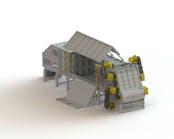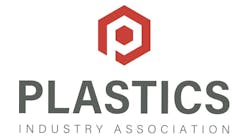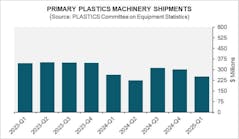Extrusion dies are configured so that they can be removed when the user needs to change the shape of the extruded product. However, this design can result in resin leaks from the boundary between the extrusion machine head and the die.
The patent, granted to Fuji Seiko Co. Ltd. and Fuji Shoji Co. Ltd., describes an extruder that has a die seat situated on the body of the extrusion head and a mechanism that presses a holding device against the front surface of the die. The pressing mechanism also may include a cam and a bolt that presses the die against the die seat.
“The die can be pressed against the die seat and also pressed against the front surface of the head with a single bolt. This simplifies the structure for fixing the die and facilitates the task for fastening the die,” the patent states. “The die can be strongly pressed against the head with a light force that rotates the bolt. This further ensures the prevention of plastic material leakage.”
Patent 10,279,529; issued May 7
Blow molding machine. An Italian company has invented a system for blow molding food and beverage containers that uses plasma to sterilize the containers. According to the patent issued to Gea Procomac SpA, Sala Baganza, Italy, the system is structurally simpler than existing technologies and can be configured either as a rotary carousel or linear-type blow molding machine.
The system consists of two mold halves, a means to supply blowing fluid, a blowing nozzle and a plasma generator. The blowing fluid passes through the plasma generator on its way to the blowing nozzle, so that plasma is blown into the bottle parison to expand it and decontaminate it at the same time.
According to the patent, using plasma to sterilize food and beverage containers has advantages over other methods because it is fast, uses low temperatures and doesn’t use chemical agents.
Patent 10,279,531; issued May 7
Injection unit. Engel Austria GmbH, Schwertberg, seeks to patent an injection unit that has a plasticizing cylinder with a smaller outer diameter than prior devices while leaving injection forces and injection capacities unaffected.
Typically, a plasticizing cylinder has a single groove used in conjunction with an engagement element to connect the cylinder to a carrier part; this inhibits axial movement of the cylinder relative to the carrier part when it’s subjected to injection pressure.
In the newly patented injection unit, “the plasticizing cylinder has at least two grooves being axially spaced from each other, and at least two engaging elements engage with the … grooves in order to form a positive-locking connection between the plasticizing cylinder and the carrier part,” the patent states. “Therefore, an axial movement of the plasticizing cylinder relative to the carrier is inhibited.”
By using a second groove, it is possible to reduce the outer diameter of the plasticizing cylinder, which reduces the costs for the materials used to manufacture the cylinder.
Patent application 20190134869; published May 9
Powder removal. Farmington, Conn.-based United Technologies Corp. received a patent for an invention that cleans conglomerated metal powder from the non-line-of-sight internal passages of 3-D printed parts.
The patent describes a tool with a flexible, snakelike portion that can be steered through the internal passages, and a head that in some embodiments contains a laser emitter and a nozzle to spray a cooling liquid such as water or liquid nitrogen. The tool is designed to cause sharp, powerful thermal shocks to the partially sintered metal powder in the passages via rapid heating and cooling. Other embodiments of the tool include other elements in the head, such as a fiber-optic camera or air nozzle. The diameter and length of the tool can be customized.
3-D printing can be used to produce a variety of products, including molds with complex channels.
Patent 10,232,414; issued March 19
Patents and patent applications can be viewed at www.uspto.gov
Have you applied for or received a patent? Contact editorial@plastics machinerymagazine.com






